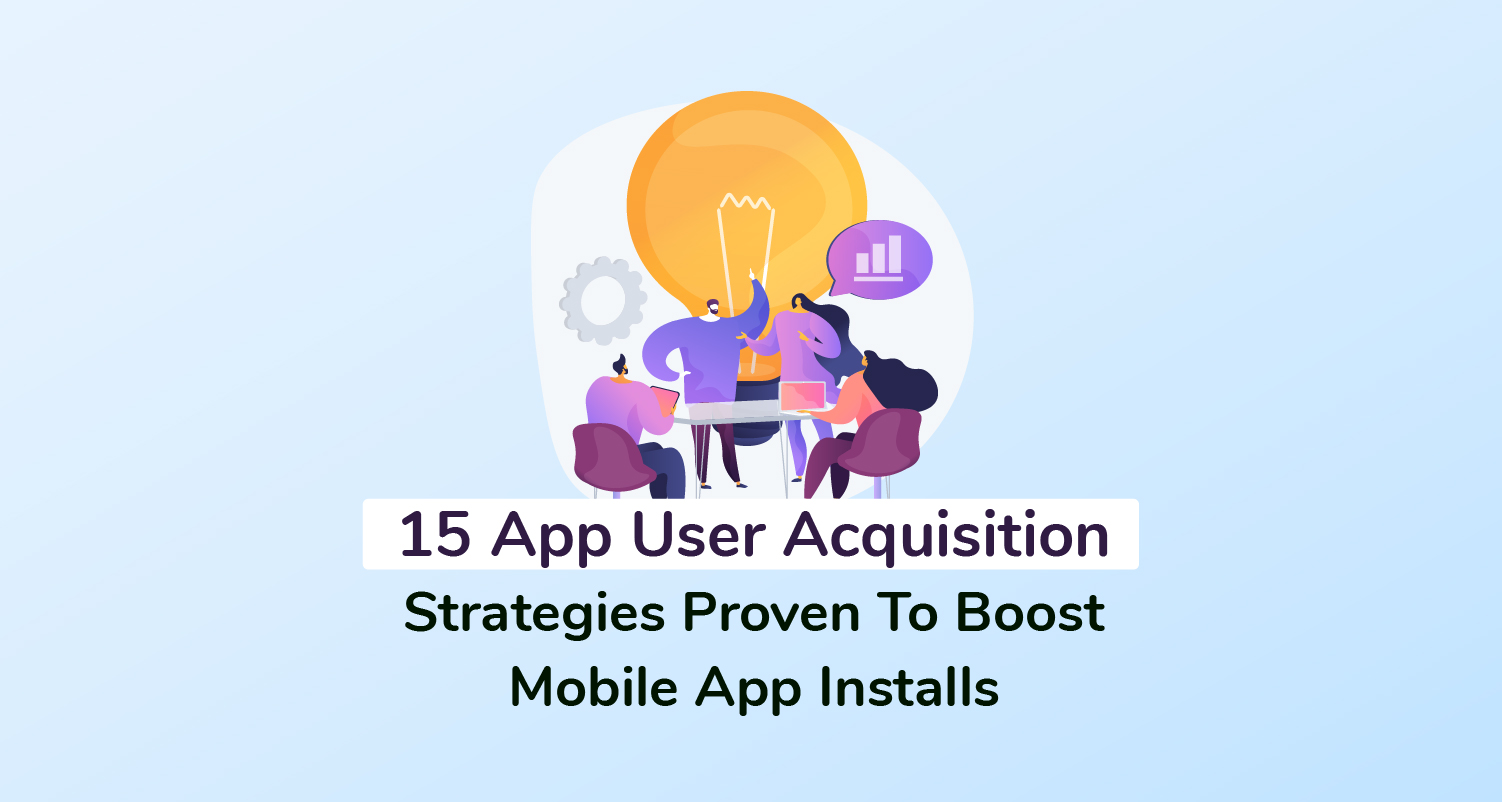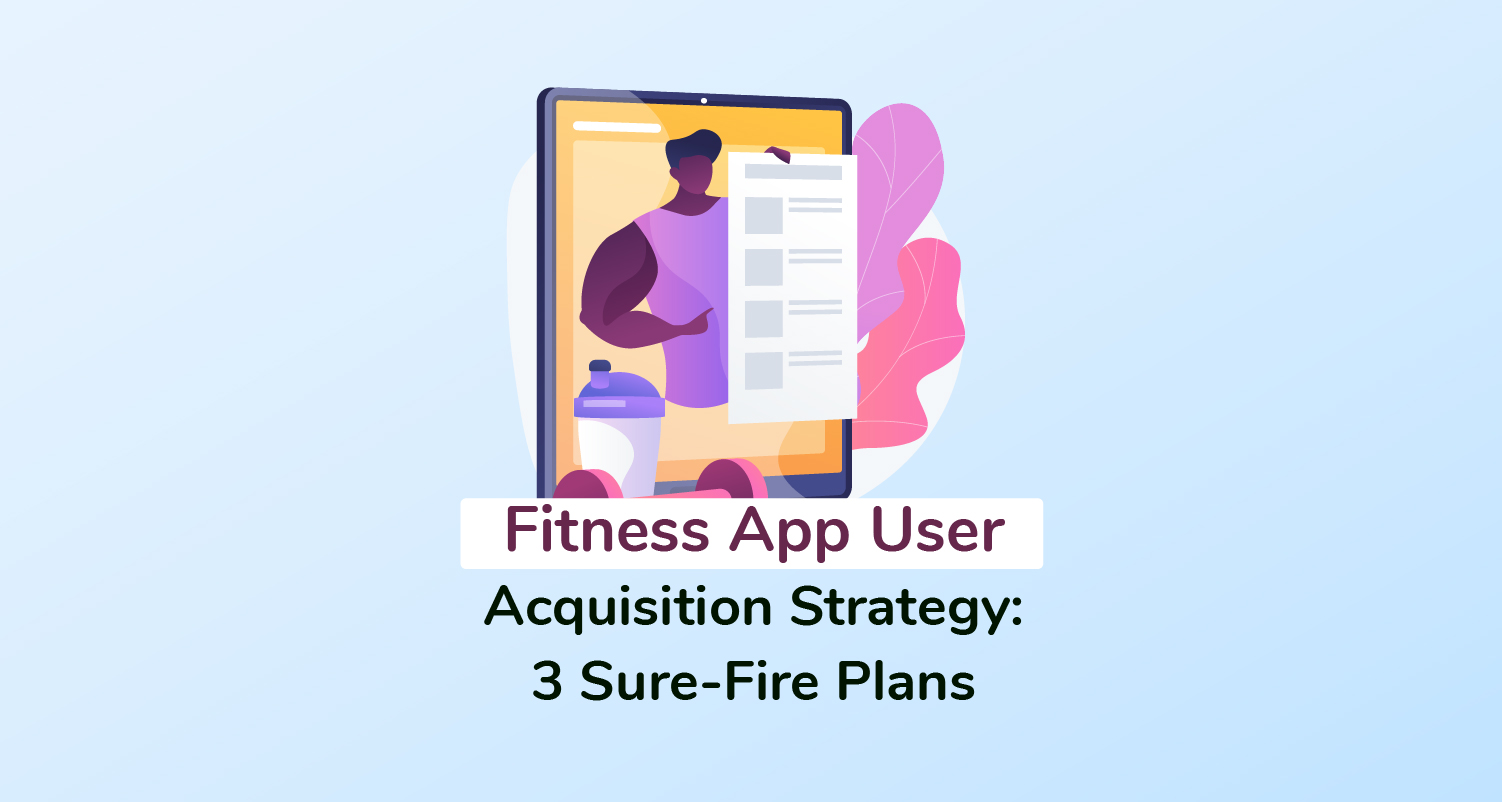
App User Acquisition vs App User Retention – Ultimate Failproof Strategies
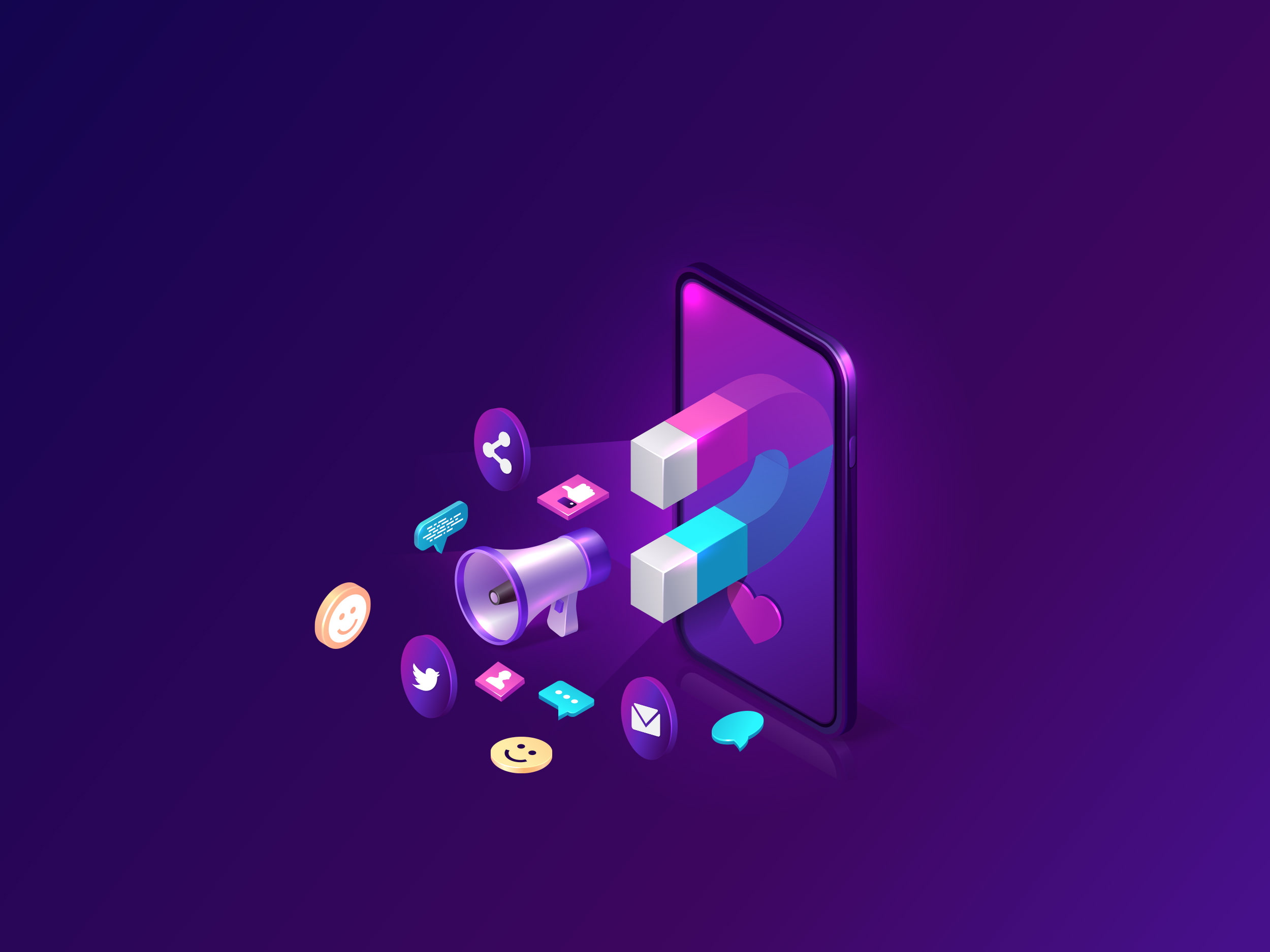
Table of Contents
1. The Connection Between Mobile App Marketing, User Acquisition, and User Retention
2. Organic App Marketing vs. Paid App Marketing
3. Mobile App User Acquisition, User Activation, And Mobile App User Retention
4. 5 Top App User Acquisition Channels
- #1. Pre-Launch App Marketing
- #2. App Press Release
- #3. App Store Optimization
- #4: Viral Mobile Apps Marketing
- #5. Paid Mobile App Marketing
5. 2 Top App User Retention Channels
- #1. Push Notifications
- #2. In-App Messages
6. Establishing If Your Mobile App Marketing Works
7. Mobile App Marketing Metrics
Admittedly, user acquisition and user retention are two terms that have been mistakenly used interchangeably for quite some now – particularly in the world of mobile app marketing.
They might sound like one and the same thing to some individuals, but the fact is, these are two completely different beasts.
So, what is mobile user retention? And how different is it compared to app user retention? Which of the two should you prioritize – user acquisition or user retention?
Ok, to understand how to approach user retention strategies and user acquisition campaigns, let’s start from the top – with mobile app marketing.
The Connection Between Mobile App Marketing, User Acquisition, and User Retention
Mobile app marketing, for starters, is all about promoting your app through a wide range of campaigns and channels, which are principally classified into organic mobile app marketing and paid app marketing.
These two sets of approaches are generally used in tandem to drive traffic to an install page, convert users into paying customers, and keep them coming back for more.
Organic App Marketing vs. Paid App Marketing
Organic mobile app marketing fundamentally seeks to achieve authentic interactions with real prospects. With time, you get to build your brand’s following, and subsequently convert followers into real app users. It’s an extended system that encompasses both user acquisition and user retention strategies like app store optimization, social media marketing, and content marketing – all of which might take a lot of effort over the long haul.
In contrast, paid app marketing attempts to influence potential users more directly, over a short period of time. Instead of waiting for your target audience to discover your app’s brand and then grow to like it, you hit them with paid ads right off the bat.
Make no mistake, though. While your organic and paid mobile app marketing strategies might be successful at driving app downloads and app installs, it turns out the average app is ultimately deleted less than six days after installation.
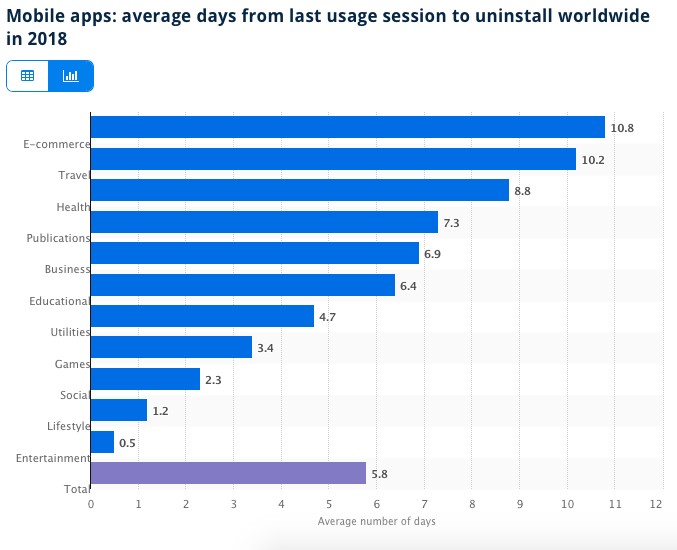
Now that’s precisely where mobile app user acquisition meets app retention.
Mobile App User Acquisition, User Activation, And Mobile App User Retention
Promoting your app is not just about app downloads. Having marketed more than 3,300 apps already, I can tell you for a fact that mobile app marketing goes far beyond this level.
You see, PreApps has helped its apps gain more than half a billion downloads so far. But, we don’t usually stop there. After user acquisition, go ahead and engage user retention campaigns to keep mobile app users on the apps.
But, why is that important?
Ok, spreading the news about your app to its target audience is essential. Getting them to download is important too. But, you know what’s more critical?
While user acquisition is extremely important, it only pays off if you couple it with effective user retention strategies. You need to keep the app downloaders in your app for long periods of time so you can progressively generate revenue from them, and, consequently, recover the user acquisition costs.
The latest mobile app usage statistics indicate that about 25% of apps are used only once within the first 6 months of acquisition. Not even mobile games are spared.
The highest the rate has gone in 10+ years is 26% back in 2010 – which subsequently dropped to 22% between 2011 and 2013, followed by 20% in 2014, and then 21%-25% between 2015 and 2019.
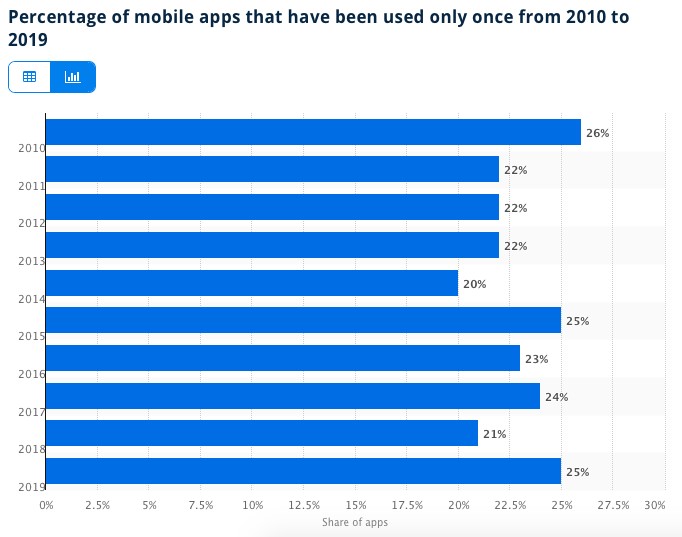
With such alarmingly poor figures, it has become extremely crucial for mobile app marketing to extend all the way to the end – from when your target audience first hears about your app to when they ultimately become regular users.
In a nutshell, you could say mobile app marketing is like a funnel with the following stages:
- User Acquisition refers to the process of interacting with your target market through various app user acquisition channels, in a bid to convince potential users to download and install your app.
- User Activation follows after the user acquisition process. As soon as your app is installed, mobile app marketing attempts to trigger registration and initial engagement. New users subsequently respond by entering their email addresses, or possibly granting various access permissions to your app.
- User Retention comes last – because this is where mobile app marketing seeks to keep users engaging with the app on a permanent basis. The principal objective is to generate real value from every single app download.
And so, to define the entire mobile app marketing framework accordingly, let’s dive deep into the interaction funnel to explore promotion strategies for acquiring as well as retaining users.
There are numerous mobile app marketing strategies designed for both user acquisition and user retention – and both are equally important.
5 Top App User Acquisition Channels
#1. Pre-Launch App Marketing
Come to think of it, pre-launch app marketing is like what’s widely known as the “snowball effect.”
Imagine building a small ball and then releasing it from the top of a hill. Chances are, it’ll pick up more snow particles as it rolls, and progressively expand on its way down the hill.
Ultimately, by the time it reaches the base of the hill, it will have collected enough snow particles to make a large, visibly-outstanding mass that’s capable of crushing through various barriers.
And that’s essentially how prelaunch app marketing goes. You start promoting your app way before its release, then watch the resultant buzz develop slowly from a small snowball to an enormous one.
In essence, you take advantage of app review platforms, social media (Facebook, Twitter, Instagram, etc), landing pages, automated emails, blogs, and app press releases to let the market know that something big is cooking.

By spreading the word before Apple even approves your app, you’ll be making the app a star before it becomes one. And in the end, you’ll launch it to a market that’s already excited about the prospects of downloading and trying out its features. That’s how you start driving user acquisition.
#2. App Press Release
Reaching out to a wide audience base requires a solid PR strategy. While most of the effective mobile app marketing tactics here take a lot of effort and resources, a good app press release happens to be different.
You only need to create a comprehensive media kit that’s interesting and convincing enough to capture the attention of the masses.
You could, for instance, compile app demo videos, logos, banners, icons, screenshots, plus a detailed but brief review guide write-up to highlight all the unique features that set your app apart from its competitors.
That said, the only problem is bound to be finding a prominent media platform and convincing them to publish as well as share the news widely. According to a recent survey of journalists, it emerged that more than half of them (53%) around the globe are not interested in press releases. Their mailboxes receive an overwhelming number of poorly composed submissions on a regular basis.
So, to avoid all the frustrations that come with app press releases, do yourself a favor and work with a specialized mobile app marketing agency that enjoys close ties with popular media platforms.
#3. App Store Optimization
Commonly abbreviated as ASO, App Store Optimization is pretty much like SEO, but in the context of the App Store. In other words, App Store Optimization is a combination of mobile apps marketing techniques that tweak various listing parameters to make an app more discoverable by the App Store search algorithm.
Now, it’s worth noting that the Google Play store search is actually the leading app discovery method among Android users, while Apple users overwhelmingly rely on the App Store search.
This certainly makes ASO one of the most critical strategies when it comes to mobile app user acquisition. You simply cannot afford to compromise even the tiniest details.
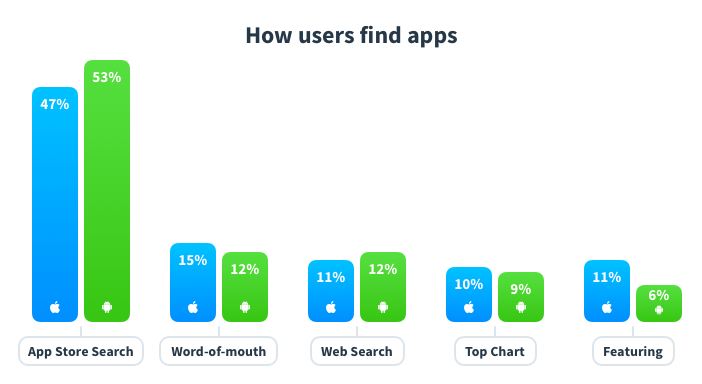
Now, make no mistake about it. Implementing ASO is not as simple as it may seem. You’re required to tweak multiple elements and then monitor your app’s performance, while persistently making adjustments based on trend changes.
For starters, you have the app name to worry about. You can’t just pick a random app name because it happens to sound good. You should first conduct research about your target market’s search patterns, their preferred keywords, and the corresponding competition scene.
Then using the findings, you can come up with an ideal, discoverable app name, plus a brief, compelling, and well-composed app description – complete with all the high-value app store keywords.
While you’re at it, you might also want to develop attractive descriptive visuals for your App Store page. I’m talking about things like the app icon, screenshots, and the app demo video. The better impression you make, the higher your App Store rank is expected to climb.
And that’s not all. There are still additional elements – like your app’s reviews and overall usage rate – that come into play when ranking the App Store Search results. Apple seemingly doesn’t take anything for granted.
#4. Viral Mobile Apps Marketing
Going viral is, undeniably, the one thing that’s capable of making your mobile app a celebrity overnight. If your promotion content turns out to be extremely relevant and engaging, you might be able to reach millions of potential users in an unbelievably short period of time. Social media users are always willing to share interesting stuff with their followers.
For instance, the car-sharing app Get Around partnered with several notable celebrities and influencers to promote their app shortly after its launch. This certainly created a lot of buzz on social media as many of the videos and images received hundreds of thousands of views.
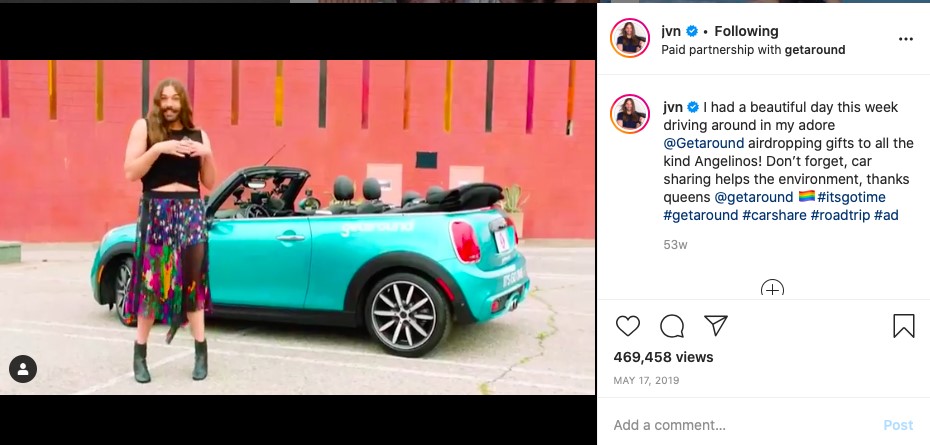
Don’t get me wrong, though. While social media usage is growing exponentially, triggering a viral campaign is a challenging (and potentially expensive) undertaking. Viral mobile app marketing requires a high level of finesse and experience.
In a nutshell, you should be able to expertly leverage urgency, exclusivity, user incentives, influencers, humor, press engagement, and audience interactions.
#5. Paid Mobile App Marketing
Like we’ve said already, paid mobile app marketing is the shortcut to promoting your app. You get to capitalize on various paid ads to place your app right in front of your target audience.
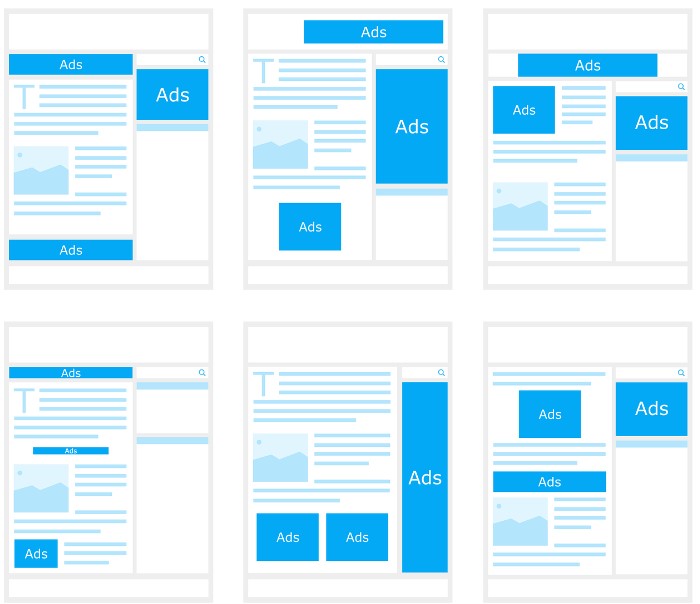
Apart from cross-network promotions, some of the most popularly used paid user acquisition options include Google Universal App Campaign, CPI ad platforms, App Store Search Ads, Promoted Tweets, and Facebook Ads.
Combined, they come in handy when you need to supplement your organic app marketing efforts.
2 Top App User Retention Channels
#1. Push Notifications
Push notifications are special display messages launched by an app while it’s running in the background. Contrary to typical texts, they normally appear on the lock screen or home screen to alert users.
When it comes to user retention, push notifications are quite reliable for engaging your app users with graphical, highly-personalized messages.
#2. In-App Messages
In-app messages are a lot like push notifications. You basically send them through your app to randomly target users with personalized engagements.
The only difference is – while push notifications ride on inactive apps, in-app messages are essentially displayed while users are actively interacting with the app.
Establishing If Your Mobile App Marketing Works
To get the best out of your mobile app marketing, it’s highly advisable to leverage multiple strategies at once. We’ve done it many times with our proven tactics, and we’ve seen the immense potential of a comprehensive app promotion framework.
Now, with such a system in place, I bet you’d want to find out how each individual mobile app marketing technique is performing.
Are your app marketing efforts reaching the target audience?
How is the market responding? Are you gaining or losing users?
And most importantly, is your overall mobile app marketing generating positive ROI?
Mobile App Marketing Metrics
There are many variables you could track depending on the type of insights you need. That said, here are some of the most important mobile app marketing metrics we’ve used to evaluate our strategies across numerous apps:
- User Lifetime Value
- Return on Ad Spend
- Return on Investment
- Average Revenue Per User
- Cost of Acquisition
- Retention Rate
Check out our comprehensive mobile app marketing metrics guide to get the full details.
Key Takeaways
- Mobile marketing is basically any type of marketing delivered via mobile.
- Mobile app marketing, on the other hand, is all about promoting your app.
- Organic app marketing fundamentally seeks to achieve authentic interactions with real prospects and drive them to download your app and retain them as a using (and paying) customer.
- Paid app marketing attempts to influence the audience more directly with ads, over a short period of time.
- 25% of apps are used only once within the first 6 months of acquisition.
- User Acquisition refers to the process of interacting with your target market to convince prospects to download and install your app.
- User Activation attempts to trigger registration and initial engagement.
- User Retention seeks to keep users engaging with the app on a permanent basis.
- Pre-launch app marketing involves promoting your app way before its release, and then watching the resultant buzz develop progressively.
- A good app press release is a comprehensive media kit that’s interesting and convincing enough to capture the attention of the masses.
- App Store Optimization is a combination of mobile apps marketing techniques that tweak various listing parameters to make an app more discoverable by the App Store and Google Play Store search algorithm.
- Viral mobile app marketing should be able to expertly leverage urgency, exclusivity, user incentives, influencers, humor, press engagement, and audience interactions.
- Push notifications are special display messages launched through an app while it’s running in the background.
- While push notifications ride on inactive apps, in-app messages are essentially displayed when users are actively interacting with the app.
Conclusion
No matter what your niche, you are going to face some fierce competition when launching an app. Therefore, your app marketing strategy needs to be comprehensive to capture your audience’s attention from multiple angles.
So, how do you think you should set up these mobile app marketing tactics to generate the best possible results for your app? Do you know how to promote your app in the best possible way, both organically and through paid advertising? Which of these strategies do you think would work best for your specific app?
Get in touch with us today to find out the answer. Our team at PreApps has helped thousands of people successfully launch and market their mobile apps. We would be more than happy to help you too with mobile user acquisition and user retention.
Feel free to let us know if you need some expert advice on how to develop a solid mobile user acquisition/retention strategy for your specific app.
Newsletter
Don’t miss a thing! Sign up to receive daily news
Subscribe Newsletter





